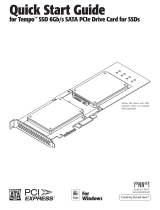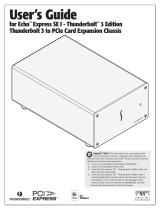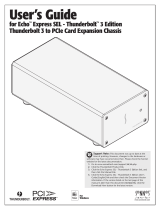Page is loading ...

Sonnet M.
2
4
x
4
PCIe
®
Card
Quick Start Guide

2
Introduction, Compatibility Information, and Card Description
Congratulations on your purchase! The Sonnet M.2 4x4 PCIe
Card provides a handy way to install up to four M.2 format
PCIe SSDs into a PCIe slot. macOS
®
, Windows
®
, Linux
®
, and
Thunderbolt
™
compatible, this card works in compatible
computers and Thunderbolt-to-PCIe card expansion systems.
Computer Compatibility
• Mac Pro
®
5,1 (Mid 2010 & Mid 2012) with available full-length
x16 PCIe slot (also requires a recommended Metal-compatible
graphics card)
• Mac Pro 7,1 (2019) – Use x16 PCIe slot (slot 3, 4, or 5) for full
performance
• PC desktop or server with available full-length, full-height x16
PCIe slot (PCIe 3.0 slot is preferred for best performance)
OS Compatibility
• macOS 10.14.4+ (macOS Catalina compatible)
• macOS 10.13.6 compatible under specific circumstances; visit
https://www.sonnettech.com/product/m2-4x4-pcie-card.html
and view Technical Notes for information
• Windows 10 (64-bit Edition Version 1903 or greater)
• Linux Kernel 5.0+
M.2 SSD Compatibilty
Only single-sided (components on top side) SSDs are supported.
For a list of compatible SSDs, please visit the Sonnet website
at: https://sonnettech.com/support/downloads/manuals/M2_
compatiblity.pdf
Thunderbolt Compatibility
• Mac
®
or Linux computer with Thunderbolt 3 or Thunderbolt 2
ports via a Thunderbolt-to-PCIe card expansion system with
available full-length x16 PCIe slot
• Windows computer with Thunderbolt 3 ports via a
Thunderbolt 3 to PCIe card expansion system with available
full-length x16 PCIe slot
Card Description
1 – M.2 SSD Sockets
The Sonnet M.2 4x4 PCIe Card supports the installation of
four single-sided M.2 2280 NVMe PCIe SSDs with “M” key
connectors. When configuring them as RAID volumes, Sonnet
recommends the use of identical SSDs.
2 – Smart Blower
This blower is temperature-controlled and spins only when
and as fast as needed, minimizing noise.
3 – SSD Heatsink
Backed with a thermal transfer pad that contacts the SSDs’
components, the heatsink conducts heat away from the SSDs.
4 – Cover
The cover directs airflow over the heatsink to provide proper
cooling for the SSDs. Always use the card with the cover
installed; this will help prevent thermal throttling of the SSDs’
performance, and may help extend the life of the SSDs.
Support Note: This document was up to date at the
time of printing. However, changes to the hardware or
software may have occurred since then. Please check the Sonnet
website for the latest documentation.
1. Go to www.sonnettech.com/support/kb/kb.php
2. Click the Computer Cards link.
3. Click the PCIe Cards link.
4. Click the Sonnet M.2 4x4 PCIe Card link, and then click the
Manual link.
5. Click the Sonnet M.2 4x4 PCIe Card Quick Start Guide [English]
link, and then check the Document Version information. If the
version listed is later than this document (revision F), click the
Download Now button for the latest version.

3
SSD Installation Steps
1. Handling the card by its edges, remove the Sonnet
M.2 4x4 PCIe Card from its packaging.
2. Place the card upside-down on a flat, level surface
(Figure 1).
3. Using a Phillips screwdriver, remove the four screws
securing the cover to the card (Figure 1). Set aside
the screws.
4. Using a Phillips screwdriver, remove the five screws
securing the heatsink to the card (Figure 2). Set
aside the screws.
5. Flip the card over, and then remove the four screws
as shown (Figure 3). Set aside the screws.
Figure 2
Figure 3
Figure 1
Support Note: When handling computer
products, you must take care to prevent
components from being damaged by static electricity.
Before opening your computer or removing parts
from their packages, always ground yourself first by
touching a metal part of the computer, such as a
port access cover, and work in an area free of static
electricity; avoid carpeted areas. Handle all electronic
components by their edges, and avoid touching
connector traces and component pins.

4
SSD Installation Steps
6. Handling it by its edges, remove an SSD from its
packaging.
7. Insert the SSD component side up into one of the
SSD sockets until it snaps into place (Figure 4).
8. Repeat steps 6 and 7 with any remaining SSDs you
are installing (Figure 4).
9. Using screws you removed previously, secure the
SSD(s) to the card (Figure 5); do not overtighten
the screws. If you installed fewer than four SSDs,
reinstall remaining screws into the open holes.
10. Set the heatsink on top of the SSDs, aligning the
screw holes in the heatsink with the corresponding
holes in the card (Figure 6).
Figure 4
Figure 5
Figure 6

11. Holding the heatsink firmly against the card, flip
the Sonnet M.2 4x4 PCIe over (Figure 7).
12. Secure the heatsink to the card with five of the
screws you removed previously (Figure 7); do not
overtighten the screws.
13. Place the card on top of the cover as shown,
and then secure the cover to the card with the
four remaining screws you removed previously
(Figure 8); do not overtighten the screws.
Card Installation Steps
1. Shut down your computer or expansion chassis,
disconnect its power cable, and then open it to
access the expansion card area (PCI Express slots);
refer to the user manual for specific information
2. Locate an available x16 PCIe slot and remove its
access cover if necessary.
3. Install the Sonnet card with attached SSDs into
the slot; make sure the card is firmly seated and
secured (use the computer’s PCIe card retaining
latch if present).
4. Close your computer or expansion chassis.
5. Reconnect the computer’s power cable.
5
SSD Installation Steps
Figure 7
Figure 8

Formatting SSDs
macOS:
Use Disk Utility (found in the Utilities folder within the
Applications folder) to format installed SSDs.
Windows:
If you intend to format SSDs connected to the Sonnet card using
Windows drive formatting tools (Disk Management), you may
locate instructions by using “format volume”, and “create striped
volume” as search items in Windows Help.
Linux
Use the tools or utilities you would normally use to format
internal drives.
RAID Configuration Support Information
macOS:
Sonnet M.2 4x4 PCIe supports RAID 0, RAID 1, and concatenated
disk set configurations of SSDs under macOS 10.14.4 and later.
Additionally, RAID 5 configuration is supported via third party
software (sold separately).
Windows:
Sonnet M.2 4x4 PCIe supports RAID 0, RAID 1, RAID 5, and
concatenated disk set configurations of SSDs.
Windows:
Sonnet M.2 4x4 PCIe supports RAID 0, RAID 1, RAID 5, and
concatenated disk set configurations of SSDs.
Booting From Attached SSDs
macOS:
Sonnet M.2 4x4 PCIe supports booting from JBOD (non-RAIDed)
SSDs when the card is installed in Mid 2010, Mid 2012, and 2019
Mac Pro computers and Thunderbolt-to-PCIe card expansion
systems.
Please note that in some cases it may be necessary for you to hold
the option + R keys during a start, and then select the startup disk
attached to the Sonnet card.
Booting from an external SSD in macOS 10.14.4+ requires
enabling external booting in the security preferences that can be
set in a command-R (recovery system) boot.
Windows and Linux:
Sonnet M.2 4x4 PCIe Card does not support booting in computers
running Windows or Linux.
Card Installation Steps and Support Information
Contacting Customer Service
The Sonnet Web site located at www.sonnettech.com has the
most current support information and technical updates. Before
contacting Customer Service, please check our Web site for the
latest updates and online support files, and check this Quick Start
Guide for helpful information.
Email support requests generally receive the fastest responses, and
are usually processed within a 24-hour period during normal
business hours, excluding holidays. When you contact Customer
Service, have the following information available so the customer
service staff can better assist you:
• Product name
• SSD model(s)
• Date and place of purchase
• Computer model
• OS version
• A System Report (macOS), or a Microsoft System Information
MSINFO32 (Windows) report (Windows), along with a
description of the issue(s) you are encountering with your
device
If further assistance is needed, please contact us at:
USA, Canada, or Mexico Customers
Please contact Sonnet Customer Service at:
E-mail: support@sonnettech.com
Tel: 1-949-472-2772
(Monday–Friday, 9 a.m.–5 p.m. Pacific Time)
For Customers Outside North America
For support on this product, contact your reseller or local
distributor.
Visit Our Web Site
For the most current product information and online support files,
visit the Sonnet web site at www.sonnettech.com. Remember to
register your product online at https://registration.sonnettech.com
to be informed of future upgrades and product releases.
Support Note for Windows Users: Use of Samsung
SSDs in computers running Windows requires the download
and installation of NVMe drivers from Samsung; Microsoft Windows
inbox NVMe drivers do not support Samsung SSDs. Download the
drivers from https://www.samsung.com/semiconductor/minisite/
ssd/download/tools/
©2019 Sonnet Technologies, Inc. All rights reserved. Sonnet and the Sonnet logotype are trademarks of Sonnet Technologies, Inc. Mac, the Mac logo, macOS and Mac Pro are trademarks
of Apple Inc., registered in the United States and other countries. Thunderbolt and the Thunderbolt logo are trademarks of Intel Corporation in the U.S. and/or other countries. Other
product names are trademarks of their respective owners. Product specifications subject to change without notice. QS-FUS-SSD-4X4-E3-E-F-112519
/






